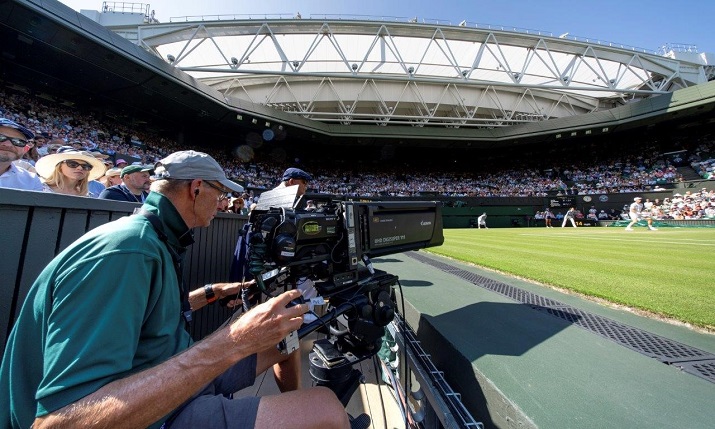Live from Wimbledon 2023: Upping UHD and HDR coverage of the Championships

Wimbledon Broadcast Services (WBS) expanded its UHD-HDR offering this year, with coverage of every match from Centre Court and No.1 Court at this year’s Championships captured in UHD-HDR.
“We had produced Centre Court in UHD-HDR since 2018, and the motivation to change came as part of the new contract with NEP,” says WBS broadcast technical manager James Muir.
NEP UK provides the technical broadcast delivery for the Wimbledon Championships, having signed a four-year deal with WBS that runs from run from 2023 to 2026.
Speaking with SVG Europe during this year’s Championships, Muir explains the approach for Centre and No.1 Court: “We moved to a single workflow, so we are not producing a separate HD output and a UHD output. Now, we make everything in the master format and convert for everything else.”

WBS broadcast technical manager James Muir
The new workflow included UHD-HDR feeds plus the HD SDR feeds for rights holders; in order to deliver the HD SDR feeds the workflow required 224 channels of conversion. The 16 other courts were available in either 1080p HDR or 1080p SDR.
“Our take was that Centre and No.1 are the two premium, top courts, and everything else we then upgraded. Aside from a slight limitation in some of the technology we use for our robotic courts, everything else has gone to 1080p, with most of it being 1080p HDR.
So courts 2, 3, 4, 12, 18 – all of the TV show courts and the courts that have human camera operators on the court, EVS operators, vision mixers – they’re all produced in HDR as well.
“The great thing with that is broadcast facilities that were built in the last 10 years or even before that, can still move 1080p pictures around easily without taking up bandwidth and storage. But it still gives that significant noticeable increase in picture quality,” says Muir.
“The two main courts are produced in UHD with their own dedicated facilities – two independent IP trucks. All of the other courts we do from a central infrastructure in one format, so we can keep it all working interchangeably and easily move stuff around.”
Read more Live from Wimbledon 2023: Paul Davies on mic’ing up players and boosting behind the scenes access
Initial planning for the expanded offering began more than a year ago, with Muir working with NEP UK’s technical projects and engineering teams to design a workflow, with testing taking place in March.
Muir explains: “We brought the No.1 Court truck in and set up around Court 18, just because it’s the easiest and most convenient. Anyone who’s done lots of work in HDR knows that you can spend an awfully long time trying to get the colours correct, which absolutely needed to happen. But two weeks before the Championships would not have been the time to do that because the rig schedule is so tight.
“So we brought in the truck and some cameras, and set up some tests. We even got a mannequin from the shop and put a high vis vest on it; we had loads of multicolour things that might appear, various lights might – everything to work it out.
“Then we went through the different LUTs that we wanted to use and the different conversion techniques; for example, what happens if we convert it through EVS? As a file-based conversion, then how does it look? If we convert it from Adobe Premiere? How does it look if we use this converter versus that converter?
“If a broadcaster recorded the match feed live and then they’ve gone to the central content store to get a camera ISO to put in a highlights cut, and one has been converted live and one has been converted in postproduction, they’ve got to look the same…so we spent a lot of time comparing monitors which gave us a really good base point. Then, in practice week, when we saw people actually hitting tennis balls on the court, there was just a little bit of tweaking that happened.”
The response from broadcasters has been positive, says Muir. Takers include the BBC, Sky in Germany and Italy, Stan in Australia, NHK Japan – plus ESPN for test purposes.
“They all say it looks fantastic, because it does. We’re blessed with the fact that we get great looking grounds, bright sunshine, blue skies, white clouds – all the stuff that HDR wants to see. And we’ve got the beauty cameras to show it off.”
Muir adds that having been captured with a higher dynamic range, the quality of the converted SDR feeds had improved too. “They’ve improved because we’re now making them from pictures that had more details to start with.”
Another motivation for the upgrades to image quality, explains Muir, is to preserve the content for future generations.
“Last year, we had a project of 100 years of Centre Court, which involved watching 100 years of archive. There was stuff that’s really old and was on film that looked fantastic, because film digitises really nicely. There was the period in the 80s and the 90s, where it was all Digibeta, and it doesn’t really scale up too well, because the quality wasn’t there to do it. And then HD television came along and it started to look good again. When someone cuts the 200-year video, we don’t want them to be sitting there going, ‘this looks awful’. They will want to have it in the best possible quality, so we will archive it in the best possible quality.”
Read more Live from Wimbledon: Whisper serves up expanded Championships coverage


